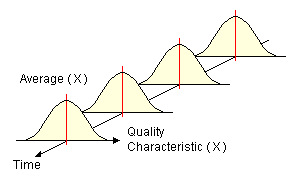In the 1920s, Dr. Walter Shewhart addressed the question of variability in manufacturing processes. From his studies, he concluded that there were two types of variation:
Controlled variation is the result of a complex system of chance causes which are an inherent part of the process itself. Such variation cannot be assigned to a single factor, because the influence of any individual element is minimal, and it is only the combination of the various elements which produce the observable variation. This type of variation is present in all natural systems, and it has two important features from the viewpoint of quality control:
A process which exhibits only chance cause variation may be said to be in a state of statistical control. 
This diagram represents a process that is in control - it is both stable and predictable. The curves represent the process variation in respect of a particular quality characteristic (X). For example, in a metal rolling process, X might be the thickness of the sheets produced. Each curve gives the distribution of the measurements of X for the entire output of the process during a given time period, one hour for example. You can see that at each hour, the distribution of X remains the same, and the average value of X is consistently on the target value. It is important to remember that this is not a natural state for a process. Without continual monitoring, any process will tend to drift out of control. |